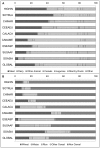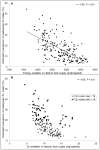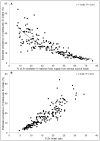Estimating the global prevalence of zinc deficiency: results based on zinc availability in national food supplies and the prevalence of stunting
- PMID: 23209782
- PMCID: PMC3510072
- DOI: 10.1371/journal.pone.0050568
Estimating the global prevalence of zinc deficiency: results based on zinc availability in national food supplies and the prevalence of stunting
Abstract
Background: Adequate zinc nutrition is essential for adequate growth, immunocompetence and neurobehavioral development, but limited information on population zinc status hinders the expansion of interventions to control zinc deficiency. The present analyses were conducted to: (1) estimate the country-specific prevalence of inadequate zinc intake; and (2) investigate relationships between country-specific estimated prevalence of dietary zinc inadequacy and dietary patterns and stunting prevalence.
Methodology and principal findings: National food balance sheet data were obtained from the Food and Agriculture Organization of the United Nations. Country-specific estimated prevalence of inadequate zinc intake were calculated based on the estimated absorbable zinc content of the national food supply, International Zinc Nutrition Consultative Group estimated physiological requirements for absorbed zinc, and demographic data obtained from United Nations estimates. Stunting data were obtained from a recent systematic analysis based on World Health Organization growth standards. An estimated 17.3% of the world's population is at risk of inadequate zinc intake. Country-specific estimated prevalence of inadequate zinc intake was negatively correlated with the total energy and zinc contents of the national food supply and the percent of zinc obtained from animal source foods, and positively correlated with the phytate: zinc molar ratio of the food supply. The estimated prevalence of inadequate zinc intake was correlated with the prevalence of stunting (low height-for-age) in children under five years of age (r = 0.48, P<0.001).
Conclusions and significance: These results, which indicate that inadequate dietary zinc intake may be fairly common, particularly in Sub-Saharan Africa and South Asia, allow inter-country comparisons regarding the relative likelihood of zinc deficiency as a public health problem. Data from these analyses should be used to determine the need for direct biochemical and dietary assessments of population zinc status, as part of nationally representative nutritional surveys targeting countries estimated to be at high risk.
Conflict of interest statement
Figures







References
-
- Brown KH, Rivera JA, Bhutta Z, Gibson RS, King JC, et al. (2004) International Zinc Nutrition Consultative Group (IZiNCG) technical document #1. Assessment of the risk of zinc deficiency in populations and options for its control. Food Nutr Bull 25: S99–203. - PubMed
-
- Brown KH, Peerson JM, Baker SK, Hess SY (2009) Preventive zinc supplementation among infants, preschoolers, and older prepubertal children. Food Nutr Bull 30: S12–40. - PubMed
-
- Hess SY, King JC (2009) Effects of maternal zinc supplementation on pregnancy and lactation outcomes. Food Nutr Bull 30: S60–78. - PubMed
-
- Haider BA, Bhutta ZA (2009) The effect of therapeutic zinc supplementation among young children with selected infections: a review of the evidence. Food Nutr Bull 30: S41–59. - PubMed
-
- Hess SY, Peerson JM, King JC, Brown KH (2007) Use of serum zinc concentration as an indicator of population zinc status. Food Nutr Bull 28: S403–429. - PubMed
Publication types
MeSH terms
Substances
LinkOut - more resources
Full Text Sources
Medical

